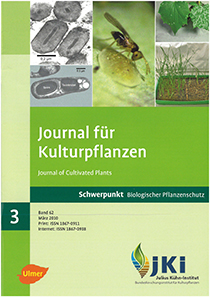Experiences with biological control in horticulture
DOI:
https://doi.org/10.5073/JfK.2010.03.06Keywords:
Biological pest control, whitefly, Encarsia formosa, area with biological pest control, increase of areaAbstract
Beneficial insects like Encarsia formosa and Phytoseiulus persimilis have been introduced into greenhouses in Baden-Wuerttemberg since 1979. The demonstration of the successful use of biological pest control in pilot greenhouses helped growers to accept the new plant protection method. The acceptance of the method was further promoted by newly established consulting and advisory services. For a number of cultures the former State Institute for Plant Protection in Stuttgart developed concepts for the use of beneficials that include all aspects of plant protection. These concepts were recommended to the growers. In the meantime, more than 50 species of beneficials are available in Germany. Thus, additional areas of application like ornamentals and interior plantscapes were opened for biocontrol. An important problem has always been the unintentional importation of pest species (invasive species) like Frankliniella occidentalis, Bemisia tabaci or Liriomyza huidobrensis, which are often highly resistant against many insecticides. Here the use of biocontrol solved many problems. Meanwhile, the use of beneficials is the standard procedure in protected vegetable cultures (cucumbers, eggplants, tomatoes etc.) in Baden-Wuerttemberg, being applied on nearly 100 per cent of the glasshouse area cultivated with these crops. In ornamental plant production the acceptance of biocontrol is still increasing. It is important to constantly simplify and improve the use of beneficials by innovations.
Downloads
Published
Issue
Section
License
The content of the journal is licensed under the Creative Commons Attribution 4.0 License. Any user is free to share and adapt (remix, transform, build upon) the content as long as the original publication is attributed (authors, title, year, journal, issue, pages).
The copyright of the published work remains with the authors. The authors grant the Journal of Cultivated Plants, the Julius Kühn-Institut and the OpenAgrar repository the non-exclusive right to distribute and exploit the work.







